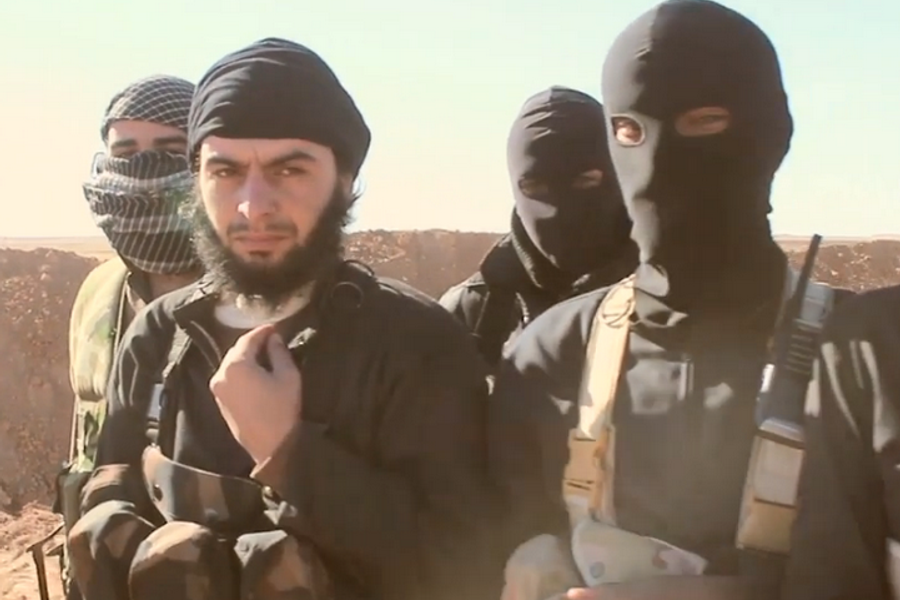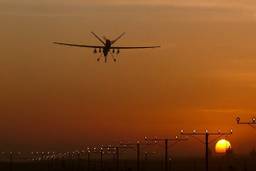ISIS: Managers of Savagery
The sectarian brutality of ISIS has allowed Syrian President Bashar al-Assad to disingenuously play the victim: the arsonist masquerading as a firefighter.
Muhammad Idrees Ahmad

Two parallel developments have contributed to the rise of the Islamic State (IS): the U.S. invasion of Iraq and consequent marginalization of its Sunni minority, and the abandonment of the people’s uprising in Syria by the international community.
Prior to the invasion, the Jordanian militant Abu Mus’ab al Zarqawi was a marginal figure. The war gave him a foothold: He stepped into the security vacuum and launched Al Qaeda in Iraq (AQI). Zarqawi’s project was aided by the ham-fistedness of the occupying authorities. Viceroy Paul Bremer’s disbanding of the Iraqi national army and purging of Baathists from state bureaucracies created a large pool of disaffected Sunnis. With little to lose, many of them put their arms and military training in the service of the insurgency. The alienation was complete when, in its attempt to divide the nationalist uprising, the U.S. empowered sectarian death squads and deployed Shia and Kurdish forces to the restive Sunni stronghold of Fallujah.
After the new Iraqi government launched an assault on the Sunni town of Tal Afar in September 2005, Zarqawi declared war on Iraq’s Shia Muslim population, and AQI became a home for Sunnis fearful of Shia domination. But the majority of Iraq’s Sunnis remained wary of its motives: The scope of AQI’s ambitions — establishing a pan-Islamic Sunni caliphate — transcended Iraq’s borders, and, with its legions of foreign fighters, it remained an alien presence.
Conscious that the welcome might not last, Zarqawi decided to give his operation an Iraqi veneer. In January 2006, he formed the Mujahideen Shura Council (MSC), bringing together six mostly local Salafi (puritan Sunni) groups with an Iraqi as its nominal head. Three months later, Zarqawi was killed in a U.S. airstrike and MSC folded shortly thereafter. It was superseded in October 2006 by the Islamic State of Iraq (ISI).
But Sunnis resented interlopers like Zarqawi turning their political marginalization into an excuse for sectarian strife. They wanted a stake in Iraq’s future, not the endless insecurity that ISI guaranteed. Neither did they care for ISI’s provocations — the bombing of Shia shrines, the slaughter of civilians — which turned them into unwitting targets of Shia retribution. (Even al-Qaeda’s central leadership was leery of its brand being associated with a narrowly sectarian agenda.) An uprising of Iraqi Sunni tribes, with encouragement and support from the U.S., eventually drove ISI out of Iraq’s cities and towns, and in April 2010, its two leaders were killed in a raid by the U.S. Joint Special Operations Command (JSOC).
It was the uprising in Syria, which began in March 2011, and Bashar al Assad’s brutal response to it that revived ISI’s fortunes. It started as a peaceful, non-sectarian and popular movement for democratic rights and dignity. But under the regime’s relentless assault, some regime opponents were forced to pick up arms. The jihadis did not enter the fray until a year later, though even then they remained a marginal force: By August 2012, the CIA could count no more than 200 in the opposition’s ranks. Nationalists seeking the regime’s overthrow dominated the insurgency. But starved of international support, the mainstream rebellion withered.
August 2013 proved a turning point. The Assad regime had called America’s bluff and launched a sarin attack on the neighborhoods of Eastern Ghouta, deliberately crossing the “red line” that President Barack Obama had promised would trigger an intervention. Obama failed to match tough words with action, and an emboldened regime escalated the war. Mainstream rebels aligned with the West were discredited. The jihadis’ star rose.
Under its new leader Abu Bakr al Baghdadi, ISI had expanded its operations into Syria. In April 2013, it officially rebranded itself the Islamic State of Iraq and the Levant (al-Shaam) — ISIS. Its operational coherence was bolstered by the many former Iraqi soldiers in its ranks; its numbers were swelled by jihadis released from Assad’s prisons in 2011. Many of these men had in the past been infiltrated into Iraq by the Assad regime to keep the U.S. in check. But, as the occupation wound down, the jihadis found themselves arrested on return.
Careful to avoid direct confrontation with the regime where it could, ISIS expanded its presence mainly by seizing territory from Syrian rebel groups. It used this territory to impose its medieval rule and continue its war of attrition against the anti-Assad rebellion. ISIS assassinated its leaders and harassed its fighters; it also intimidated or disappeared civil society activists.
With ISIS’s presence growing increasingly intolerable, the Syrian resistance struck back. Beginning on New Year’s Day 2014, rebel groups including the Free Syria Army (FSA), the Islamic Front (IF), Ahrar al-Sham (AS) and even the official al-Qaeda affiliate Jabhat al-Nusra (JAN) united to drive ISIS out of Idlib, Deir Ezzor, much of Aleppo and the environs of Damascus.
But by 2013, the dynamics in Iraq had shifted. Following the U.S. withdrawal, the remaining checks on Iraqi Prime Minister Nouri al-Maliki’s sectarian rule had been lifted. Inspired by the Arab Spring, the disaffected and vulnerable Sunni population protested. But like Assad, Maliki responded with repression and barrel bombs; his forces acted like occupiers.
Sunni anger grew. In summer 2014, ISIS and the former Iraqi general Izzat Ibrahim al-Duri’s Naqshbandi Army finally rode the wave of mounting resentments for a lightning advance across northern Iraq. Caught by surprise, the numerically superior Iraqi army disintegrated. It abandoned its American-supplied arms to the ISIS spearhead. Mosul fell, Sunnis celebrated. And, with its enhanced firepower, ISIS returned to Syria in triumph.
Asserting its broader aspirations, ISIS dropped the geographical reference from its name. The Islamic State (IS), as it is now called, declared a global “caliphate” and, through a series of gruesome atrocities, successfully baited the U.S. into intervening militarily. Its victims were journalists and aid workers, all well-wishers of the Syrian people. Its bloodlust even made Al Qaeda recoil. Al Qaeda had always had an uneasy relationship with its Zarqawiite offshoot. But the mutual antipathy finally burst into the open when Al Qaeda chief Ayman al Zawahiri ordered ISIS disbanded, and Baghdadi refused. In February 2014, Al Qaeda officially repudiated ISIS.
These developments are recounted in painstaking detail in Michael Weiss and Hassan Hassan’s indispensable ISIS: Inside the Army of Terror. Beyond history, the book presents a granular analysis of the IS’s organization, ideology, funding and recruitment. The book explains the strategic logic of the group’s spectacular cruelty while giving readers a glimpse of the IS mindset through a series of interviews with its cadre. It also describes the common experiences that set its leaders on the path of jihad (Zarqawi was radicalized in a Jordanian prison; Baghdadi at the American Camp Bucca). It also shows how the IS secured the loyalty of tribes under its rule by buying or bludgeoning them, using coercion or cooptation.
By contrast, Patrick Cockburn’s The Rise of Islamic State: ISIS and the New Sunni Revolution is a high-altitude polemic that blames the IS’s rise on U.S. and Saudi support for the anti-Assad rebellion. It has little or nothing to say about IS ideology or composition. Acting more as an advocate than an observer, Cockburn argues for rapprochement with the Assad regime.
But to make his case, Cockburn dispenses with proportion and distinction. Though in successive reports the U.N., Amnesty International and Human Rights Watch have indicted the Assad regime as by far the leading perpetrator of violence in the conflict, Cockburn’s account is devoted almost entirely to opposition atrocities. (He reports exclusively from regime-held areas.) Regime repression does receive cursory mention, but Nazi analogies are reserved for the opposition.
Cockburn makes no mention of the divergent interests and active rivalries between IS and Syria’s nationalist opposition. For him, to assist the opposition is to assist the IS.
To support this claim, he quotes “an intelligence officer from a Middle Eastern country neighboring Syria” who told him “ISIS members ‘say they are always pleased when sophisticated weapons are sent to anti-Assad groups of any kind because they can always get the arms off them by threats of force or cash payments.’” (Cockburn quotes many anonymous intelligence officials in the book but on no other occasion does he grant the country anonymity. Might it be because the “country neighboring Syria” is Iraq, a key Assad ally?)
Yet this bias is the least of the problems in Cockburn’s reporting — he also embellishes. On page 89 of his book, he writes about Adra: “I witnessed JAN forces storm a housing complex by advancing through a drainage pipe which came out behind government lines, where they proceeded to kill Alawites and Christians.” This would be the first independent verification of a story that had briefly surfaced before disappearing in a swirl of contradictory claims. The Russian broadcaster RT had even used fake pictures in its report on the incident.
Yet Cockburn was nowhere near Adra. This is confirmed by an unimpeachable source: Patrick Cockburn. He first reported on the incident in his January 28, 2014 column for The Independent. But instead of being personally present, the story about rebels advancing through a drainage pipe is attributed to “a Syrian soldier, who gave his name as Abu Ali.” Cockburn appears to have pulled a Brian Williams.
Pace Cockburn’s insistence that the Assad regime and the Kurds are the only forces capable of defeating the IS, Weiss and Hassan adduce evidence showing that the regime has deliberately avoided confrontation with the IS. The authors cite a study from the Carter Center that confirms that the regime has spared the IS in 90 percent of its attacks. An IHS Jane’s Terrorism and Insurgency Center (JTIC) study is even more damning. It reveals that in 2014, only 13 percent of the IS attacks were directed at the regime; in turn, the regime targeted the IS in only 6% of its attacks. The brunt of both groups’ furies has been directed at the Syrian people.
None of this is acknowledged in Cockburn’s analysis. Earlier in February, as the regime launched a particularly savage series of bombings against the Syrian town of Douma, killing up to 250 civilians, Cockburn reprised his criticism of the West for “trying to overthrow President Bashar al-Assad whose army is the main military opponent of ISIS.” The IS can be defeated, Cockburn argued, if western powers united with the regime. But if the critical factor is western power, he doesn’t say why it shouldn’t back Syrian rebels, who actually have a record of fighting and defeating the IS.
Cockburn’s prescriptions notwithstanding, this is what the U.S. appears to be doing for now. In its assault on the IS, it has acted in coordination with the Assad regime — functioning, in effect, as its air force — and, like the regime, made no distinction between various rebel groups, targeting the IS as well as its Islamist adversaries in JAN and AS.
For the Assad regime, the IS has proved a godsend.
Since the beginning, the regime has tried to paint the uprising as an extremist revolt against a secular government. The IS confirms this stereotype. Cruelty is central to its operational logic. The IS practices a doctrine expounded in a text called Management of Savagery by a jihadi ideologue with the nom de guerre Abu Bakr Naji. It prescribes a form of warfare to which “violence, crudeness, terrorism, [deterrence] and massacring” are central.
The IS has elevated sectarian revanchism into a political project. And this has allowed Assad — who deliberately used a sectarian strategy to divide a cross-denominational revolt — to disingenuously play the victim: the arsonist masquerading as a firefighter.
Cockburn echoes and amplifies this line. This inversion of cause and effect has led to a situation where western powers are now inflaming the very factors that led to the rise of the IS. In Iraq, the US is arming Iranian-backed Shia militias whose excesses engendered the IS backlash; in Syria the U.S. is coordinating airstrikes with the still-rampaging regime, even relying on its intelligence. (The only exception was Kobane, where airpower helped the Kurds and the FSA repel an IS offensive.)
But on any given day one has to do no more than survey the previous week’s events for perspective. On February 19, the BBC reported that the Kurdish YPG and three Syrian rebel groups — the groups that Cockburn insists don’t exist– advanced into the IS stronghold of Raqqa to capture 19 villages.
The “main military opponent of ISIS” was meanwhile busy elsewhere. On February 17, during their brief occupation of the town of Retian in Aleppo, regime forces executed at least 21 civilians, according to the Violations Documentation Centre. (The Syrian Observatory for Human Rights places the figure at 49.) Four days later, on the first anniversary of the U.N. Resolution 2139, which demanded an end to the indiscriminate bombing of civilians, Syrian Civil Defence workers recorded 15 barrel bombs dropped on Aleppo. None of this registers in Cockburn’s inverted ideological portrait.
The virtue of Weiss and Hassan’s book is that it places the people of Syria front and center; Cockburn, on the other hand, views everything through the prism of state rivalries. Deductive ideological reasoning allows him to treat Assad’s slaughter of his own people as an act of resistance to imperialism. Cockburn’s prescriptions are aimed at remedying symptoms without addressing the cause; they guarantee perpetual war. Heeding Weiss and Hassan would put the U.S. on the side of Syria’s majority and potentially bring stability to Iraq.
CORRECTION: This review originally cited a quote as appearing on page 76 of Patrick Cockburn’s book The Rise of Islamic State. This referred to an earlier version of the book published by OR Books; in the Verso edition, the quote was on page 89, not page 76.





